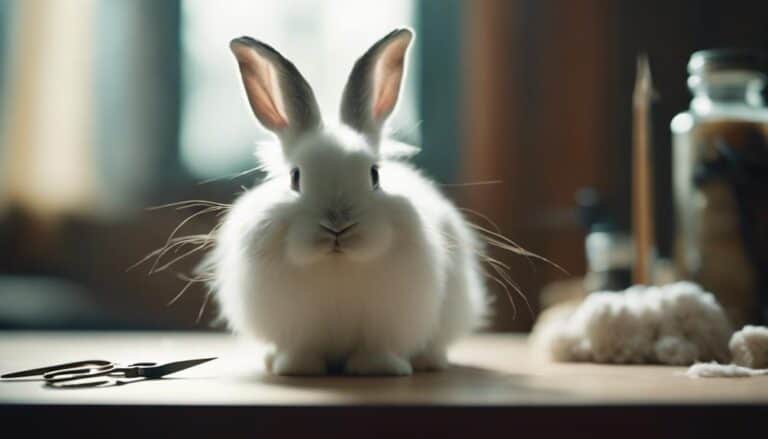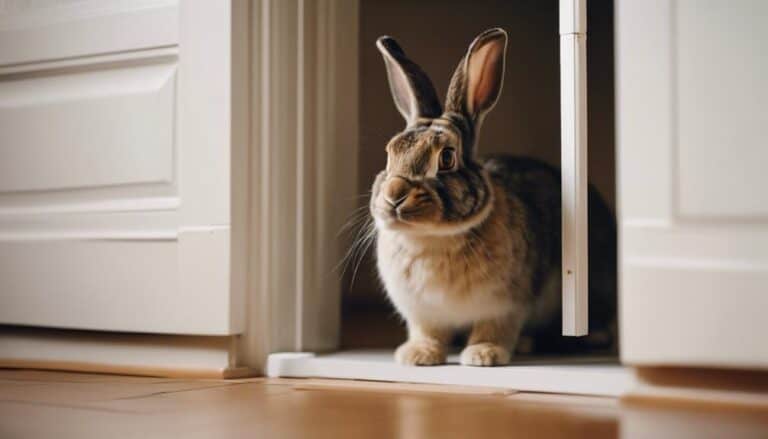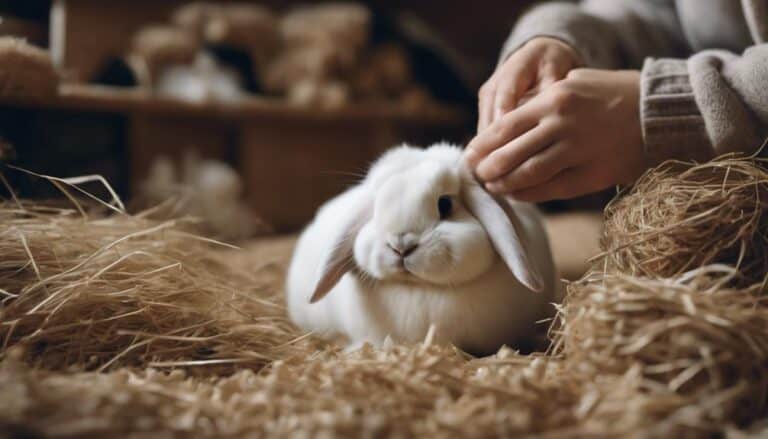You might think that bunnies are just cute, fluffy creatures without much depth, but have you ever considered the deeper meanings behind their behaviors? From the way they hop to how they groom themselves, every action holds significance.
Understanding what bunnies truly mean requires a closer look at their subtle cues and interactions. So, are you ready to uncover the hidden language of bunnies and discover the secrets they hold?
Stay tuned to unravel the mysteries behind these fascinating creatures.
Contents
Key Takeaways
- Bunnies communicate joy through hopping and dancing.
- Bunny flop signifies comfort and relaxation.
- Territorial behavior is displayed through chinning.
- Negative emotions like anger and fear are expressed through grunting and thumping.
Bunny Behavior Decoded
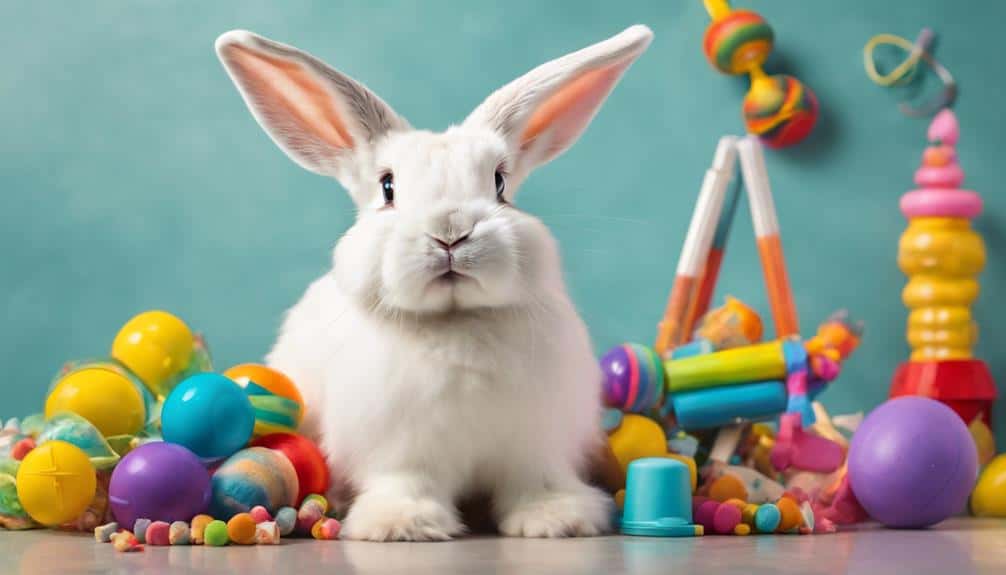
When observing bunnies, their behavior can provide valuable insights into their emotions and well-being. Understanding a rabbit's behavior is essential to ensuring their happiness and health.
Joy in rabbits is often displayed through hopping or dancing, a delightful sight that indicates their contentment. A bunny flop, where they lay on their sides with their legs stretched out, shows a deep sense of relaxation and comfort. Territorial behavior is common among rabbits, with chinning being a way they mark their ownership and boundaries.
On the other hand, grunting is a sign of anger or feeling threatened, while thumping or stomping indicates fear or danger. By decoding these behaviors, you can better cater to your rabbit's needs and create a safe and nurturing environment for them.
Understanding Rabbit Communication
Rabbit communication is a fascinating aspect of understanding these creatures, revealing a complex language of behaviors and sounds that convey various emotions and needs. When rabbits softly grind their teeth, it's a sign of contentment and relaxation, showing they're at ease. However, loud teeth grinding could indicate pain or discomfort, signaling that something may be wrong.
Circling behavior in rabbits is a unique way they show affection and bond with their companions. If you hear a rabbit scream, it's important to pay attention as this is a distress signal or a response to injury, requiring immediate care. False pregnancy behaviors in rabbits can be misleading, mimicking actual pregnancy signs such as nesting and aggression.
Understanding these signs and behaviors is essential for interpreting what your rabbits are trying to communicate. By observing their communication cues, you can better meet their needs and safeguard their well-being.
Deciphering Bunny Gestures
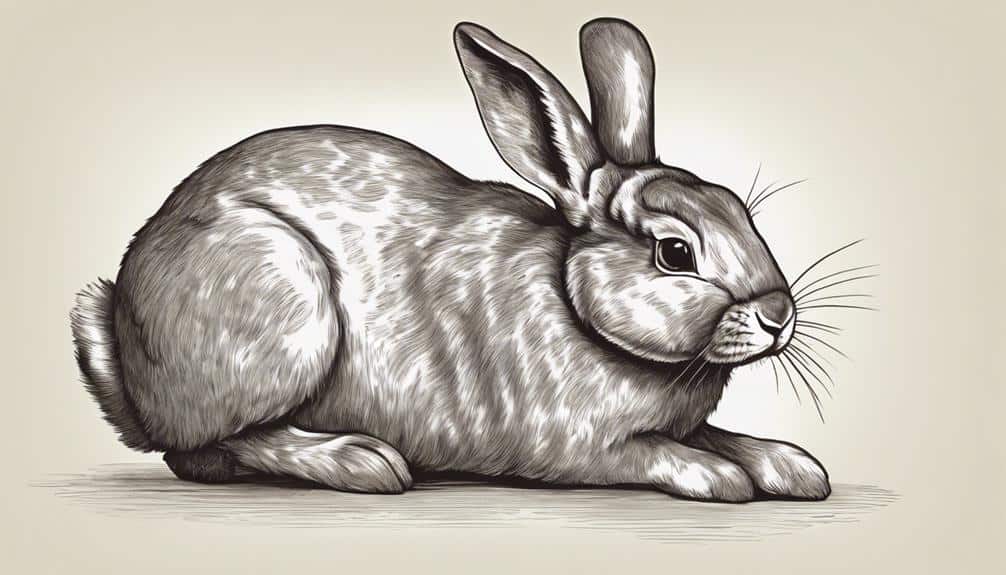
To understand bunnies better, decoding their gestures is key in establishing a deeper connection with these adorable creatures. Bunnies hold significant symbolism in various cultures, often representing fertility, life, new beginnings, and good luck. Their gestures carry spiritual meanings, serving as symbols of renewal and positivity in many traditions.
When your pet rabbit hops or dances around, it signifies joy and happiness, showing their lively spirit and contentment. The bunny flop gesture, where they lay on their side with legs extended, indicates a sense of comfort and tiredness.
Understanding territorial behavior in rabbits, such as chinning to mark ownership, helps you respect their boundaries and establish trust. Conversely, grunting signals anger or feeling threatened, while thumping or stomping expresses fear or danger. By observing and interpreting these gestures, you can better cater to your bunny's needs and make sure a harmonious bond between you both.
Interpreting Rabbit Expressions
Interpret rabbit expressions through their subtle cues and body language to deepen your understanding of their emotional state and needs.
In various ancient cultures, rabbits have represented fertility and abundance, embodying the spiritual meaning of new beginnings and growth.
When rabbits exhibit joy and happiness, they may hop or even dance playfully, reflecting their contentment. A bunny flop, where they lay on their side with legs stretched out, signals both contentment and tiredness in rabbits.
Understanding territorial behavior is key; rabbits chin objects to mark ownership of their space. On the contrary, grunting can indicate anger or feeling threatened, while thumping or stomping signifies fear or danger in their environment.
Exploring Rabbit Body Language

When observing rabbits, pay attention to their ear positions, as they communicate a lot about how the rabbit is feeling.
The movement of their tail can also indicate their mood and intentions.
Additionally, the posture of a rabbit's body reveals vital information about their emotional state.
Ear Positions Communicate
Exploring how ear positions communicate in rabbits reveals valuable insights into their mood and intentions. Rabbits, symbolizing gentleness and fertility, hold significant cultural importance in various societies.
For Native American culture, rabbits are revered as spirit animals, embodying quick-thinking and agility. In ancient Egyptian beliefs, the rabbit symbolizes rebirth and new beginnings. When a rabbit is born in the Year of the Rabbit in the Chinese zodiac, it's thought to bring good luck and happiness.
Observing a rabbit's ear movements can offer clues to their emotional state. Ears held tightly back may indicate fear or aggression, while ears pointing forward demonstrate alertness and curiosity. Understanding these subtle cues can help you better connect with these gentle creatures.
Tail Movements Indicate
Tail movements in rabbits serve as an important form of communication, conveying a range of emotions and intentions. When a rabbit's tail is held upright, it signifies curiosity and exploration. On the other hand, a lowered and still tail could indicate relaxation or contentment in the rabbit.
Rapid circular tail movements may suggest excitement or playfulness. If you observe your rabbit's tail flicking or thumping, it might be a sign of annoyance, agitation, or a warning signal. By paying attention to these tail movements, you can gain valuable insights into your rabbit's emotions and behavior.
Understanding these cues can help you better care for and communicate with your furry friend.
Body Posture Reveals
Understanding a rabbit's body posture is essential for interpreting its emotions and intentions accurately. Rabbit body language speaks volumes about how they feel.
When a rabbit positions its ears forward, it signals curiosity or attentiveness. If you see your bunny lying down with legs stretched out, it indicates relaxation and comfort. A tail raised upright reflects excitement or happiness in rabbits. On the other hand, a hunched posture with flattened ears may suggest fear or aggression.
Unlocking Bunny Signals

When deciphering bunny signals, observe their body language and listen carefully to their sounds.
Understanding the meaning behind a rabbit's hopping, chinning, grunting, or thumping is important for effective communication with your furry friend.
Bunny Body Language
Deciphering bunny signals through understanding their body language is important for nurturing a strong bond with your rabbit.
When your rabbit is hopping around or dancing, it indicates joy and contentment. A bunny flop, where they lay on their side, signifies relaxation and tiredness.
Be mindful of territorial behavior, as rabbits may chin objects to mark their ownership. Grunting could mean your rabbit is feeling angry or threatened, while thumping or stomping signals fear or danger in their environment.
Paying attention to these subtle cues will help you better understand your rabbit's emotions and needs, allowing you to create a safe and happy environment for your furry friend.
Understanding Bunny Sounds
To truly connect with your rabbit, tuning in to the various sounds they make is key to understanding their emotions and needs. Listening to your bunny's vocalizations can provide valuable insights into their well-being.
Soft teeth grinding often indicates contentment and relaxation, while loud grinding may signal pain or discomfort. When your bunny circles you, it's a display of affection towards you. However, if your rabbit screams, it's a clear sign of distress or injury and requires immediate attention.
Additionally, be aware of false pregnancy behaviors in rabbits, which can mimic actual pregnancy signs and be misleading. By recognizing and interpreting these rabbit sounds, you can better care for your bunny and strengthen your bond.
Bunny Actions Unveiled
Observing bunny actions can provide valuable insights into the emotions and behaviors of pet rabbits. When your rabbit is hopping or dancing around, it indicates joy and happiness.
The bunny flop, where they stretch out and relax, suggests contentment and tiredness. If you notice your rabbit engaging in territorial behavior by chinning objects or people, they're marking their ownership.
However, if your rabbit starts grunting, it could mean they're feeling angry or threatened. When they thump or stomp their feet, it's a sign of fear or danger.
Understanding these actions can help you better care for and communicate with your pet rabbit. By paying attention to their behaviors and reactions, you can make sure they feel safe, secure, and loved in their environment.
The Secret Language of Bunnies
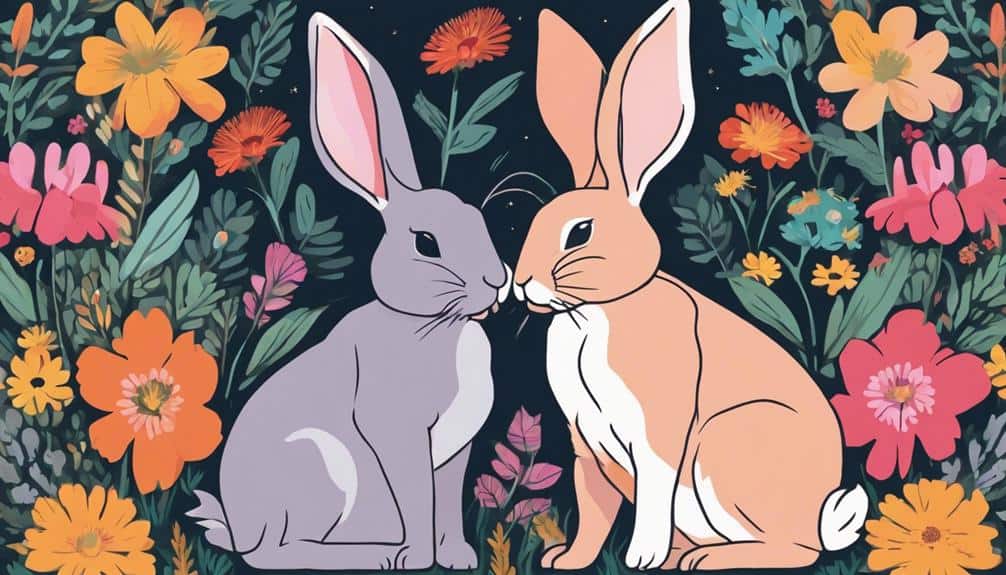
When studying the behaviors of pet rabbits, understanding the secret language of bunnies through their body cues and vocalizations is key to enhancing your bond with these furry companions.
- Body Language: Bunnies communicate through various body movements like hopping, circling, and chinning objects to mark ownership, showing their territorial behavior.
- Vocalizations: Different sounds, including screams, soft teeth grinding, and nipping, convey a range of emotions in rabbits. Tooth grinding can indicate contentment or pain, depending on the intensity, so pay close attention to these cues.
- Emotional Connection: Interpreting rabbit behavior enables you to connect with your pet bunny on a deeper level, strengthening the bond between you both. By recognizing their communication methods, you can respond appropriately to their needs, fears, and desires, fostering a harmonious relationship filled with love and understanding.
Take the time to learn and appreciate the secret language of bunnies to assure a happy and fulfilling companionship with your beloved pet.
Frequently Asked Questions
Can Rabbits Be Aggressive?
Rabbits can be aggressive when feeling threatened or stressed. Signs include biting, scratching, lunging, or grunting. Understanding bunny body language helps manage aggression. Proper socialization, handling, and environment enrichment prevent bites and foster a calm rabbit temperament.
How Do Rabbits Show Anger?
When rabbits are angry, they may stomp, growl, or avoid eye contact. Watch for ears pinned back, aggressive behavior like nipping or biting, and a lashing tail. Remember, bunnies have feelings too!
What Does It Mean When a Rabbit Hangs Around Your House?
When a rabbit hangs around your house, it's likely feeling safe and finding resources nearby. Their behavior, body language, and desire for security drive them to your space. By understanding their habits and needs, you can foster a positive human-rabbit interaction.
What to Do if a Rabbit Bites You?
If a rabbit bites you, clean the wound, apply antiseptic, and watch for infection. Seek medical help for deep bites or signs of infection. Remember, rabbits have sharp teeth. Proper care is essential.
Conclusion
Now that you have explored the captivating world of bunny behavior and communication, you may be surprised to learn that rabbits can communicate through a variety of gestures, expressions, and body language cues.
In fact, studies have shown that bunnies are capable of understanding and responding to human emotions, making them not only adorable companions but also intuitive creatures.
Keep observing and interacting with your bunny to strengthen your bond and decode their secret language.



